 21 Sep 07
21 Sep 07 21 Sep 07
21 Sep 07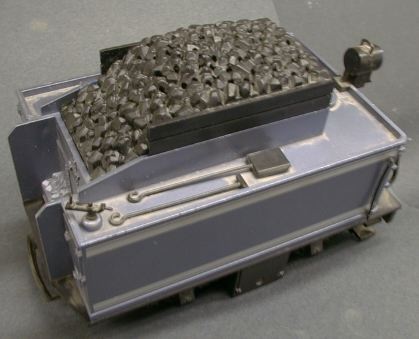 LGB has made powered tenders for many years.
This is an old (and dusty) one that matches the Lake George and Boulder
passenger starter set. Newer ones often come with sound installed, this
one has nothing inside but a lead weight.
LGB has made powered tenders for many years.
This is an old (and dusty) one that matches the Lake George and Boulder
passenger starter set. Newer ones often come with sound installed, this
one has nothing inside but a lead weight.
Powered tenders are popular as they can convert a fairly weak pulling 0-4-0 starter set locomotive into a very good puller at relatively low cost. The set also handles tight radius curves well. When the cross jumper cables are used, power pickup of the set is also materially improved.
[ Top ]
The primary reason for existence of this page is to describe a Soundtraxx Sierra digital sound installation in the tender. The tender is the obvious place for the sound system to be installed as it has adequate room inside. The locomotives typically do not have enough room.
The speaker is usually the hardest part to install in any sound system installation, and this loco was no different. Since the power brick occupies the whole underside of the tender, the usual method of mounting the speaker on the floor facing down will not work. Instead, it is mounted under the coal load facing up.
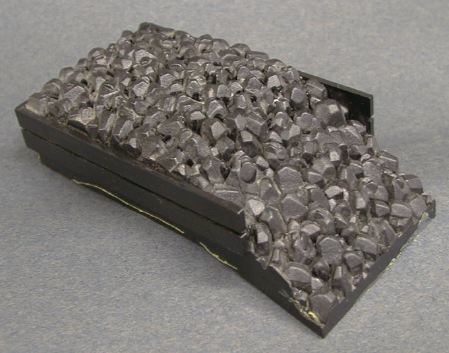 The coal load is
a separate molded piece that fits onto the top of the tender shell. It
is glued in place with a fairly weak adhesive so that it is possible to
carefully pry it off causing the adhesive to let go.
The coal load is
a separate molded piece that fits onto the top of the tender shell. It
is glued in place with a fairly weak adhesive so that it is possible to
carefully pry it off causing the adhesive to let go.
Underneath the coal load, the tender shell is solid. The area under the coal load must be drilled or removed as there is not enough room between the coal load and the tender shell to mount a good speaker. The coal load itself is fairly easy to drill in an unobtrusive fashion. I used a 7/64" drill bit to drill about 50 holes at the low spots between coal chunks. Due to the sharp relief of the coal load, these holes are not very visible. They could be disguised further if desired by attaching small pieces of real coal near each hole.
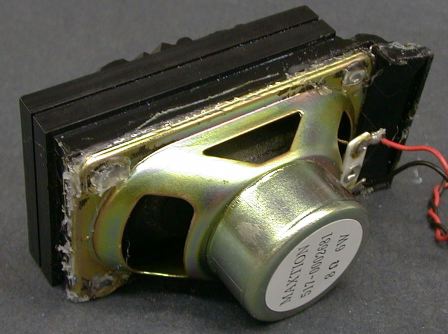 The speaker that I selected is a 2" by 3.5"
rectangular version. This particular speaker is a computer replacement
part and is very common. I found these 8 ohm 6 watt speakers at a
computer swap meet for $1 each. A version of this speaker is the one
used by Aristo in the RS-3. If you can't find a loose one around, you
can buy one as a replacement part from Aristo. This speaker barely fit
under the coal load. It is actually attached to the coal load and
sealed with hot glue. This whole assembly is then inserted into the
tender shell from the top. The advantage of using the speaker attached
to the coal load is that the load and speaker can be removed to access
the controls on the Sierra itself.
The speaker that I selected is a 2" by 3.5"
rectangular version. This particular speaker is a computer replacement
part and is very common. I found these 8 ohm 6 watt speakers at a
computer swap meet for $1 each. A version of this speaker is the one
used by Aristo in the RS-3. If you can't find a loose one around, you
can buy one as a replacement part from Aristo. This speaker barely fit
under the coal load. It is actually attached to the coal load and
sealed with hot glue. This whole assembly is then inserted into the
tender shell from the top. The advantage of using the speaker attached
to the coal load is that the load and speaker can be removed to access
the controls on the Sierra itself.
When the speaker is out, the sound quality of the system materially degrades. All the bass and some of the volume goes away. The difference in the sound quality as the speaker is inserted back into the tender shell while the system is running is astounding. A good enclosure makes an enormous difference is the performance of the Sierra.
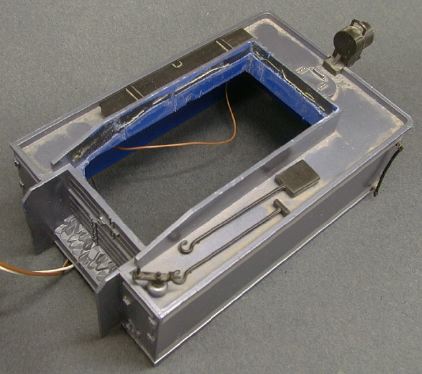 Use of this speaker required that
the whole top of the tender shell under the coal load be removed to
allow it to fit. The entire flat surface under the coal load was cut
out with a jig saw and ground flush. A 3" round speaker would also fit
underneath the top of the tender shell. In that case, the position of
the speaker should be marked and an array of 1/4" holes should be
drilled in the top of the tender shell underneath the coal load.
Use of this speaker required that
the whole top of the tender shell under the coal load be removed to
allow it to fit. The entire flat surface under the coal load was cut
out with a jig saw and ground flush. A 3" round speaker would also fit
underneath the top of the tender shell. In that case, the position of
the speaker should be marked and an array of 1/4" holes should be
drilled in the top of the tender shell underneath the coal load.
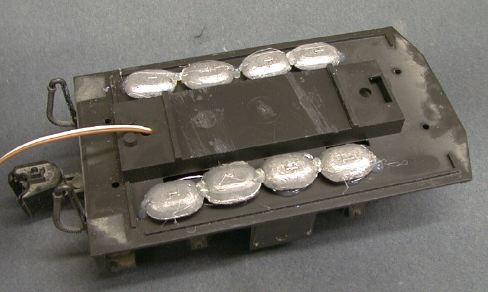 The speaker
hung deeply enough into the tender such that it interfered with the
lead weight in the center of the tender. The weight was removed and the
screw bosses used to attach it were sliced off to make room. The weight
was replaced with lead fishing weights attached to the tender floor
along the edges of the tender. The new weights, the Sierra's battery
and the speaker make up for the loss of the original weight.
The speaker
hung deeply enough into the tender such that it interfered with the
lead weight in the center of the tender. The weight was removed and the
screw bosses used to attach it were sliced off to make room. The weight
was replaced with lead fishing weights attached to the tender floor
along the edges of the tender. The new weights, the Sierra's battery
and the speaker make up for the loss of the original weight.
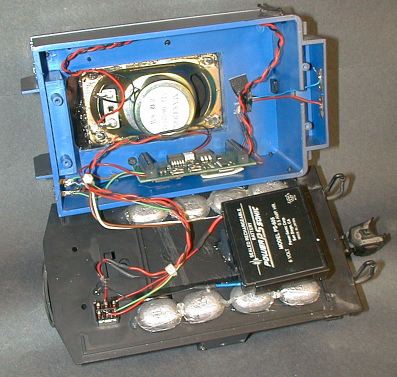 The
Sierra's battery (a slimline version in this case) is mounted to the
tender frame with foam tape and hot glue. Since the speaker hangs to
the front, the battery has to go to the rear. It won't fit any other
way. The power switch is mounted to the tender floor so that it can be
accessed from below. I didn't use a external volume control switch as
the coal load/speaker assembly can be lifted out to access the buttons
on the Sierra for changing the volume or programming. If your speaker
arrangement can't be removed, then another switch for volume control
and programming should be mounted in the same position on the other
side.
The
Sierra's battery (a slimline version in this case) is mounted to the
tender frame with foam tape and hot glue. Since the speaker hangs to
the front, the battery has to go to the rear. It won't fit any other
way. The power switch is mounted to the tender floor so that it can be
accessed from below. I didn't use a external volume control switch as
the coal load/speaker assembly can be lifted out to access the buttons
on the Sierra for changing the volume or programming. If your speaker
arrangement can't be removed, then another switch for volume control
and programming should be mounted in the same position on the other
side.
Since all the tender wheels are powered and have power contacts, there is no room on them for chuff synchronization magnets on the traditional location on the back side of a wheel set. I initially used the Sierra's automatic chuff however it never worked quite right. The chuff rate doesn't build fast enough from a standing start and it just didn't sound right. I didn't use track mounted magnets for whistle and bell control either, I let the Sierra handle that with its voltage controlled methods. However, it would not be difficult to find places on the bottom of the tender to mount the reed switches for use with track magnets.
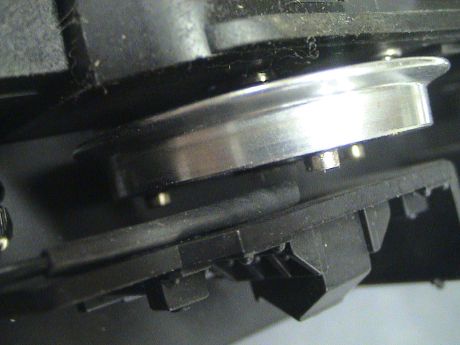 Eventually, I gave up on
the automatic chuff feature, it just doesn't quite cut it. The voltage
controlled chuff rate suffers from the same problems as the diesel
Sierra systems, they ramp up too slowly. Instead, I mounted the reed
switch that came with a Sierra system on the inside of frame facing a
wheel.
Eventually, I gave up on
the automatic chuff feature, it just doesn't quite cut it. The voltage
controlled chuff rate suffers from the same problems as the diesel
Sierra systems, they ramp up too slowly. Instead, I mounted the reed
switch that came with a Sierra system on the inside of frame facing a
wheel.
The Sierra reed switch is a good switch and it's very small, but it is also very fragile. I enclosed the switch in a piece of heat shrink tubing to give it some reinforcement. One of the wires is looped back past the switch so that both wires come out one end. This makes the switch assembly much easier to handle. Also note that the switch is somewhat sensitive to the angle of the magnets with respect to the reeds. The reeds are hard to see, but the magnets should be positioned above or below the reeds in the direction of their movement. A magnet placed to the side may trigger the switch, but at closer range. It may also double trigger the switch as it moves past.
This method produces a much better effect than the automatic chuff and I am quite pleased with the result.
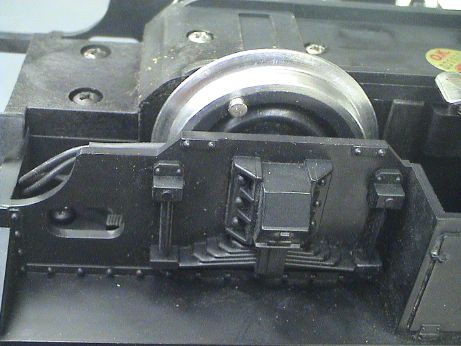 The magnets are mounted
on the outside of the wheel with Zap-A-Gap. I first tried just 2
magnets that would result in one half the prototypical rate. The chuff
rate still wasn't high enough to suit me so I installed two more. With
4 magnets (4 chuffs per driver revolution, the prototypical rate) the
Sierra couldn't keep up at the highest speeds that I wanted to run,
which were not all that fast. I took three of them off and remounted 2
of them to get 3 chuffs per turn. It was hard to place them at exactly
120° and I didn't get it exactly right, but I found that the very
slightly off cadence beat actually sounded interesting so I left them
that way. A little black paint and they virtually disappear.
The magnets are mounted
on the outside of the wheel with Zap-A-Gap. I first tried just 2
magnets that would result in one half the prototypical rate. The chuff
rate still wasn't high enough to suit me so I installed two more. With
4 magnets (4 chuffs per driver revolution, the prototypical rate) the
Sierra couldn't keep up at the highest speeds that I wanted to run,
which were not all that fast. I took three of them off and remounted 2
of them to get 3 chuffs per turn. It was hard to place them at exactly
120° and I didn't get it exactly right, but I found that the very
slightly off cadence beat actually sounded interesting so I left them
that way. A little black paint and they virtually disappear.
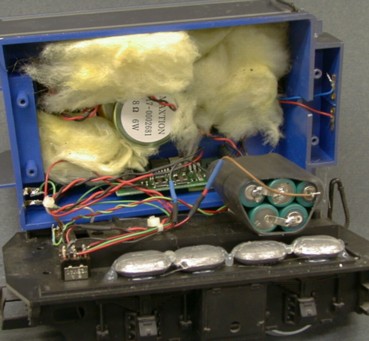 The
Sierra's own battery eventually crapped out from being left in a
discharged state too often or too long so it was replaced with 5 tabbed
NiMH AA cells. No other modifications were made to the installation to
accommodate the replacement battery pack.
The
Sierra's own battery eventually crapped out from being left in a
discharged state too often or too long so it was replaced with 5 tabbed
NiMH AA cells. No other modifications were made to the installation to
accommodate the replacement battery pack.
The original battery was replaced in August 2001. It had lasted only 2 years. As of September 2007, the replacement pack was still working fine.
This page has been accessed times since Oct 9, 1999.
© 1999-2007 George Schreyer
Created Oct 9, 1999
Last Updated September 21, 2007